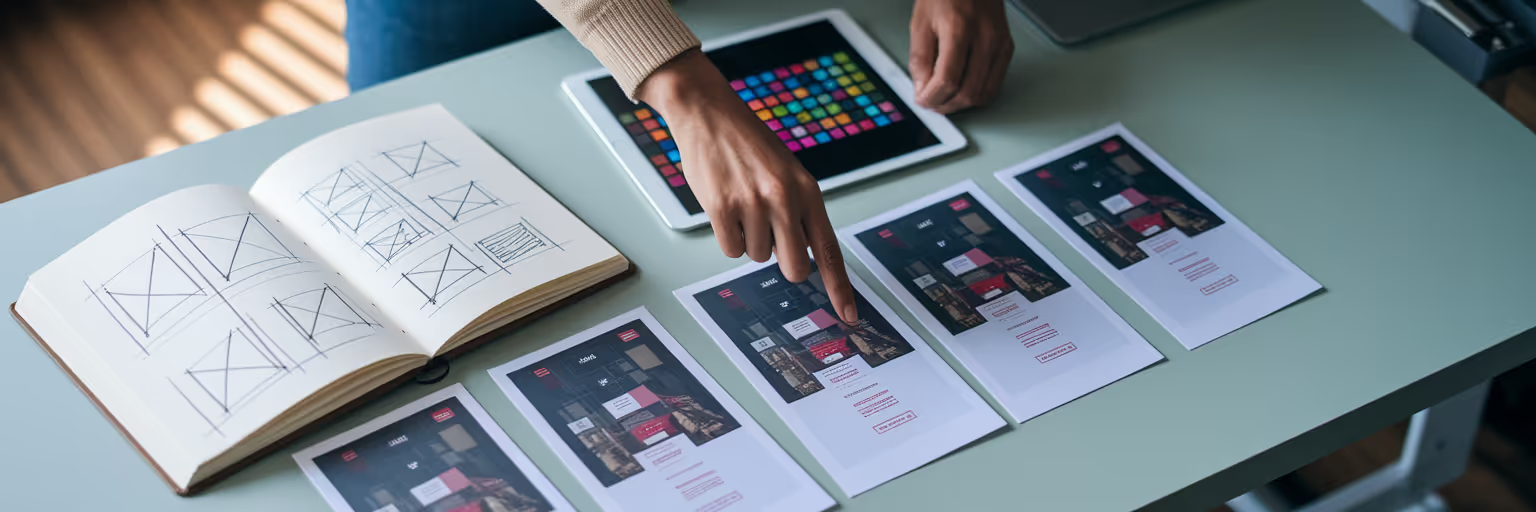We’ve all been there. You’re scrolling through portfolios, and a beautiful UI catches your eye. You take a screenshot, save the link, and tell yourself you’ll come back to it. But that folder of screenshots just keeps growing, and those links get buried under dozens of others. This common habit of "portfolio grazing" feels productive, but it's one of the biggest missed opportunities for professional growth. Learning how to analyze UX case studies is the first step toward changing that.
Why Skimming Case Studies Is Holding You Back
When you only glance at the final, polished designs, you miss the most important part of the story: the messy middle. You don't see the strategic trade-offs, the failed experiments, or the critical user insights that shaped the outcome. It’s like admiring a skyscraper without understanding the engineering that keeps it standing. Without digging into the "why," your own problem-solving skills can stagnate, leaving you with a library of pretty pictures but no real knowledge.
This passive consumption creates a dangerous illusion of learning. You might recognize a cool animation or a clever layout, but could you explain why it was the right choice for that specific product and its users? Probably not. The risk is that you end up mimicking surface-level trends without grasping the underlying principles, leading to designs that look good but fail to solve actual problems.
The difference between a good designer and a great one often comes down to active analysis versus passive consumption. Great designers don't just collect inspiration; they deconstruct it. They treat every case study as a lesson in strategy, research, and execution. A structured, visual method can transform this habit, turning that folder of forgotten screenshots into an actionable knowledge base that fuels your work.
Use Storytelling to Deconstruct Any Case Study

The best UX case studies aren’t just reports; they are stories. They have a beginning, a middle, and an end. To truly understand them, you need to think like a storyteller. A helpful mental model for this is Freytag's Pyramid, a structure used to analyze narratives. As the Interaction Design Foundation highlights, applying this framework helps you evaluate the entire project journey. By breaking a case study down into its core narrative parts, you can move beyond the visuals and start your UX case study analysis.
The Setup: Problem & Context
Every story starts with a setup. This is where the initial problem is defined and the stakes are set. Don't just accept the problem statement at face value. Ask critical questions to understand the foundation of the project:
- What was the specific user problem or business goal?
- Who were the target users, and what were their core needs and frustrations?
- What constraints (time, budget, technical limitations) were at play?
The Confrontation: Process & Challenges
This is the "messy middle" where the real learning happens. It’s full of research, iterations, dead ends, and breakthroughs. This is where the designer proves their process. Look for the details here:
- What research methods were used, and why were they chosen?
- How did the design evolve from early sketches to high-fidelity mockups?
- Where did the team pivot or change direction based on user feedback?
The Resolution: Solution & Impact
The resolution isn't just the final UI. It's the outcome. Did the solution actually solve the problem from the setup? Be skeptical and look for concrete evidence:
- How was success measured? Are the metrics meaningful (e.g., conversion uplift, task completion rate) or just vanity metrics (e.g., social media likes)?
- Does the final design directly address the user needs identified in the research?
- What were the key takeaways or lessons learned from the project?
Build Your Analysis Toolkit with Visual Bookmarking
Now that you know what to look for, how do you organize your findings? Traditional browser folders and link lists just don't cut it. They strip away visual context, making it nearly impossible to find that one specific insight you saved three months ago. We’ve all stared at a long list of cryptic URLs, trying to remember which one had that brilliant checkout flow example.
This is where visual bookmarking for designers comes in. Instead of just saving a link, tools like Bookmarkify let you capture the entire visual context. You can save the URL, but also grab screenshots of specific UI elements, data charts, and key text snippets. This transforms your collection from a list of links into a rich, visual library.
The real power lies in a robust tagging system. Imagine tagging each saved asset with parts of the story: #problem-statement, #user-research, #wireframes, and #final-ui. Suddenly, your messy folder becomes an organized database. With view modes like grid or moodboard, you can see all your saved wireframes side-by-side, making it easy to spot patterns at a glance. It’s a fundamental shift in how you collect and retrieve insights. For new projects to analyze, you can even check out curated sources like our daily inspiration feed.
| Feature |
Traditional Bookmarking (Browser Folders) |
Visual Bookmarking (with Bookmarkify) |
| Context |
Saves only the URL, losing all visual context. |
Captures screenshots, specific UI elements, and text snippets. |
| Organization |
Limited to nested folders, which become chaotic. |
Uses flexible tags (#ecommerce, #wireframe) for multi-dimensional sorting. |
| Searchability |
Relies on page titles or memory. |
Instantly searchable by tags, keywords, and notes. |
| Pattern Recognition |
Impossible to see connections between bookmarks. |
Grid and moodboard views allow for visual comparison and flow analysis. |
| Collaboration |
Difficult to share collections with context. |
Shareable collections via a single URL for team or client feedback. |
This table illustrates how a visual-first approach fundamentally changes the way designers can collect, organize, and retrieve insights, making the analysis process more efficient and effective.
A Step-by-Step Method for Deconstructing Case Studies

Ready to put it all together? Here’s a practical design inspiration workflow that combines the storytelling framework with a visual bookmarking tool to deconstruct any case study.
- Capture the Core Components
As you read a case study, actively save the key assets. Don’t just bookmark the main URL. Use a tool like the Bookmarkify Chrome extension to capture specific screenshots of the problem statement, user personas, journey maps, wireframes, and the final UI. Each piece is a clue in your investigation.
- Tag Everything with Purpose
This is where you build your searchable library. Apply the storytelling tags we discussed (#problem, #research, #solution) to each asset. Then, add descriptive tags that will help your future self, like #B2B-saas, #mobile-app, or #accessibility. The more thoughtful your tagging, the more powerful your library becomes.
- Annotate with Critical Questions
This step is what separates passive collecting from active analysis. Use the notes feature on each bookmark to challenge what you see. For a wireframe, ask: "Why this layout? What user need does it address?" For a results section: "Are these vanity metrics? How was success truly measured?" When you find interesting UX research analysis techniques, make a note of why they were effective for that project. You can even use our Design Analyse feature to inspect fonts, colors, and assets directly.
- Visualize the Narrative Flow
Once you’ve captured and tagged the key moments, arrange them in a dedicated collection or moodboard view. Lay them out chronologically to reconstruct the project's story. This visual narrative helps you see exactly how early research influenced the final design, making the entire process tangible and memorable.
From Single Analysis to Big-Picture Patterns
Analyzing one case study is good. Comparing ten is where true expertise develops. Once you’ve built a library of deconstructed case studies, you can move from being a student to a strategist. The goal is to spot patterns, trends, and recurring solutions across different projects.
Imagine you're tasked with designing a new checkout flow. Instead of starting from a blank slate, you can filter your library by #ecommerce and #checkout-flow. Instantly, you have a visual comparison of how a dozen different designers tackled that exact problem. This comparative analysis helps you uncover powerful insights, such as:
- Common solutions for specific user problems (e.g., reducing friction in form fields).
- Emerging UI patterns for certain platforms (like SaaS dashboards or mobile onboarding).
- Popular UX research analysis techniques for different project types, as detailed in resources like this overview of UX research methods.
- Recurring mistakes to avoid in your own work.
This practice isn't just about collecting ideas; it's about building a personal "mental playbook" of design solutions. You become more strategic, more efficient, and ultimately, one of the most valuable creative productivity tools on your team.
Turn Your Insights Into Action
It's time to stop skimming and start deconstructing. By treating UX case studies as stories to be analyzed, you transform passive inspiration into an organized, actionable library of design knowledge. This systematic approach will not only sharpen your critical thinking but also give you a searchable playbook of solutions for any challenge that comes your way.
Don't wait. Find one compelling case study today and apply this method. Start building your personal design library right away with Bookmarkify and see how a structured workflow can change the way you learn.
Want to keep improving your process? Explore more guides and tips on our blog to enhance your creative workflow.












